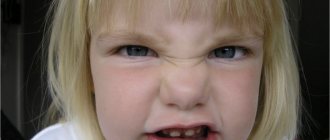Emotional well-being of preschool children and optimal ways to achieve it. consultation on the topic
“Emotional well-being of preschool children and optimal ways to achieve it”
Educational psychologist
MBDOU TsRR D/S No. 16
M.I.Aryabinskaya
Belorechensk, 2021
The development of the emotional sphere of preschool children is one of the most important areas of activity for teachers in a modern kindergarten. After all, emotions are a kind of kaleidoscope of impressions and experiences with the help of which a child interacts with the world around him, while simultaneously learning about it.
Psychological science has proven that a child aged 3-7 years experiences qualitative changes in the sphere of emotions, his views on the world and relationships with others are transformed. Kids, for example, react vividly and directly to everything that happens. Over time, older preschoolers begin to realize and control their feelings, which are a kind of indicator of the most significant needs. With the development of the emotional sphere, the child’s inner world itself changes qualitatively, which, in order to achieve harmony of feelings and sensations, as well as for the full realization of personality in life, must be bright, comfortable and positive.
The emotional sphere cannot become perfect on its own. It must be carefully studied and carefully developed. Nowadays, it is appropriate to recall the phenomenon of the “dried heart”, discovered by L.S. Vygotsky. This term refers to callousness, impoverishment, or even a complete lack of feelings in people’s relationships. The complexity of the current situation lies precisely in the fact that, in addition to the frequent shortcomings in upbringing and education, modern life itself, in which the child is directly involved, contributes to the “desensitization” of people. For example, spending a long time in front of the TV or computer, boys and girls began to interact less with adults and peers. But it is communication that greatly enriches the sensory sphere. This is why children become more selfish, emotionally isolated, overtired, and less responsive to the feelings of others. In addition, adults also do not always pay due attention to the child’s moods and experiences. Parents are often too busy to spend time on “children’s” problems. Meanwhile, the sprouts of negative feelings and emotions can bring the most undesirable fruits.
Thus, now it is especially important, with the leading role of the teacher-psychologist, to unite the efforts of educators and all kindergarten specialists, directing them to the development of the sensory sphere of children and ensuring a favorable emotional microclimate in the preschool educational institution.
Conditions for ensuring the emotional well-being of children
To ensure the emotional well-being of children it is necessary:
- unconditional acceptance of each child by adults to develop his vital sense of security and self-confidence, in his own abilities;
- positive environment for children (creating a supportive, friendly, sincere, homely atmosphere in groups);
— equality in the relationship between an adult and a child (organization of productive step-by-step cooperation, timely receipt by preschoolers of help, support and protection when the need for it arises);
- providing children with the opportunity to move freely in the group space, in other rooms of the kindergarten (for example, in the music room), and directly communicate with peers;
- flexible, personality-oriented approach: rejection of any “labels”, taking into account the mental and personal characteristics of each child, expressed, for example, in a differentiated selection of tasks and exercises, as well as the individual pace of their implementation;
— close professional cooperation between teachers and all kindergarten specialists when planning and organizing interaction with preschoolers (in particular, when developing individual educational routes for children with health and development problems);
— creating conditions for the disclosure of the personal individuality of students, i.e. early identification of their creative potential and abilities, encouragement of even small achievements of each child and his desire for independence;
— attentive attitude and sensitive response to emerging children’s problems, anxieties and fears;
- tactful communication with the child for joint “processing” of overly disturbing impressions (often negative) with the aim of gradually reducing and overcoming them, as well as increasing self-esteem.
The development of the emotional sphere of preschoolers is positively influenced by the creation of corners of psychological relief in groups:
- for kids - “housekeeping”, in a specially designated space of the group, children place objects brought from home: photographs, toys or other things reminiscent of home. This truly brings the kindergarten environment closer to a family one, solves the problem of adaptation and overcoming the often-occurring feeling of loneliness, and helps to establish a positive emotional microclimate in the group;
- for children 4-5 years old - a “tree of emotions”, on which the child, coming in the morning, places his photo in accordance with his mood - in the center or along the edges, on a dark or light background. During the day, he can make changes at will. His internal state thus becomes more understandable, and the help of an adult, if necessary, becomes effective and timely;
— for older preschoolers, a corner with upholstered furniture or modules with books, magazines, interesting board games and toys selected for a given age is suitable for emotional release. The opportunity for a 5-7 year old child to sometimes be alone, change the environment for a while and take a little break from the rapid flow of events and information is becoming increasingly relevant, because... helps prevent emotional breakdowns, overstrain, and negative moods.
Games for the development of the emotional sphere of children
The following can be used as effectively working non-standard games:
"Unusual bun"
To organize communication with preschoolers in a circle, it is customary to use a ball passed from one child to another. This helps create the mood for common activities and form a “single group space.” Experience shows that the interest of children 3-5 years old in working in a subgroup increases significantly if they are offered not just a ball, but a “bun” (a small ball with two contrasting facial expressions marked with a marker: on the one hand - cheerful, on the other - sad) . Remembering a fairy tale, a child of the junior and middle group perceives the “kolobok” as a real interlocutor, empathizes with him emotionally and, as a rule, turns to him exactly the side that reflects his mood. With the help of such a fairy-tale intermediary, even children who are not very sociable can more easily make contact with teachers and peers, are more willing to express their impressions of participating in joint games and exercises, which means they act more actively and open up emotionally.
"Live Pictures"
To the music, children take from the “magic bag” one card with the image of a fairy-tale character and carefully examine it. Upon completion of the musical fragment, each child needs to find the owner of the same picture, pair up with him and show the emotion depicted in the picture. Correctness is checked and all participants are rewarded with applause - to develop their positive emotional response to the general game interaction.
“Magic Mirror” (game exercise for individual work with children 5-7 years old)
The child is given a model of a mirror in the shape of a cube, on which facial expressions, as in the game with the “kolobok”, are depicted according to the principle of contrast (happy - sad, angry - calm). By turning the mirror and looking at the reflections, the preschooler tries to determine which one he likes and is more familiar with, i.e. suitable for him personally. This game exercise promotes the child’s active self-expression, articulation of basic experiences, prevention of various complexes and cases of unreasonable dissatisfaction with oneself, i.e. prevention of childhood depression.
“Complete the portrait” (game for children 4-7 years old, played individually or in a subgroup)
Each child gets the opportunity to “help the artist” by completing his work. On a blank portrait with already existing images of the eyes and nose, he will have to draw a mouth on his own (according to his choice, for example, with the corners up - smiling, joyful; with the corners down - sad, upset). And then, together with the teacher, he tries to guess what mood the person depicted in the picture was in and why. Children thus, in an entertaining and relaxed way, practice their ability to distinguish between manifestations of a person’s basic feelings and compare them with different emotionally charged situations.
To work with older preschoolers (5-7 years old), a similar game can be played with a three-dimensional model - balloons, attaching different smiles to them using double-sided tape (cheerful, sad, confused, plaintive). As a result, the portrait becomes complete and expressive, and the conversation with the teacher about the work done together becomes more direct and lively. With the help of this exercise, older preschoolers have the opportunity to recognize their mood among others, name it, react in a certain way, putting order in their inner world. Finding similar images among those obtained by peers further stimulates children to play together, developing the necessary skills for independent communication with peers.
“Fairytale Rainbow” (game exercise for working with a subgroup of children 5-7 years old)
To the accompaniment of music (for example, you can use compositions from A.P. Tchaikovsky’s album “The Seasons”), the participants in the game “turn” into multi-colored pencils from the artist’s box. Each “magic pencil” tries, with the help of movements, facial expressions and gestures, to show what objects it can paint with its color, the rest try to guess and name this color. In case of an accurate answer, the next participant tries his hand, and the correctly named “pencils” join hands, forming a “magical” fairy-tale rainbow. With the next inclusion of a musical fragment, the magic is completed and you can reproduce the resulting rainbow by laying it out from colored pencils or drawing it on a large sheet. This gaming exercise not only promotes the manifestation of children’s individual color preferences, but also stimulates them to unite in a gaming community, causing them to have a positive emotional response to joint activities with peers.
New, non-standard games for the development of emotions can be successfully combined with a variety of activities (from conversations and drawing to dance movements). At the same time, turning on music and using modern technical means (for example, a multimedia system) also serves to improve the overall mood and increase emotional tone.
Practice shows that the main thing in ensuring the emotional well-being of a child is a sincere interest in success, as well as the unity of views of significant adults - parents, teachers, kindergarten specialists. The main thing to remember is that the emotional sphere, which determines the future of children 3-7 years old, does not tolerate standard approaches. The search for optimal ways to achieve the emotional well-being of preschoolers must be carried out constantly, using imagination and creativity, finding your own solutions through direct communication and active interaction between adults and children.




